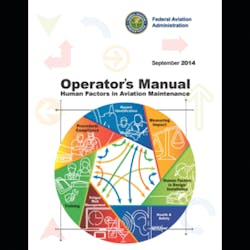Background
In 2005, the Federal Aviation Administration (FAA) completed the Operator’s Manual for Human Factors in Aviation Maintenance (Op’s Manual). That manual earned broad U.S. and international acceptance. A Spanish and Chinese translation influenced its international distribution and value. The Op’s Manual won the FAA Administrator’s Award for Use of Plain Language. Document design, simplicity, and concise delivery of technical information were the key features that made the Op’s Manual useful for maintenance and engineering personnel.
This new 2nd edition of The Operator’s Manual for Human Factors in Aviation Maintenance follows the same successful format as the 1st edition. As with the 1st edition, contributors remained disciplined to keep the information concise and limited to only relevant information. The new Op’s Manual is co-edited by Dr. Bill Johnson and Dr. Katrina Avers, from FAA .
Format
This manual recognizes that readers already know the importance of human factors — a science that pays attention to physical, psychological, and other human attributes to ensure that we complete work safely and efficiently with minimal risk to personnel and equipment. Content was based on portions of the original document. New topics were added based on relevancy, safety impact, and on industry or FAA request. The chapters discuss seven critical human factors topics.
Seven Human Factors Topics
• Event Investigation and Voluntary Reporting
• Procedural Compliance and Documentation
• Human factors Training Evolution
• Fatigue/Alertness Management
• Human Factors Health and Safety Programs
• Considering Human factors in Equipment and Installation
• Measuring Impact and Return on Investment
The references, by design, are few and limited to the highest value. The Op’s Manual is not designed to read cover to cover. Instead, the book is a reference when you want an overview and specific implementation advice on one of the topics included. Chapters have identical formats to include:
- Chapter topic introduction
- Why the topic is important
- How to implement the program component
- How to know the program component works
- Key references and links
Let’s look at each chapter.
Chapter 1: Event Investigation and Voluntary Reporting
This chapter topic is repeated for the 2nd edition. The chapter concentrates on the various methods of event reporting ranging from the classic Boeing Maintenance Error Decision Aide (MEDA) to FAA programs like Maintenance and Ramp Line Operations Safety Assessment (MRLOSA) and the Aviation Safety action program. The authors, Dr. Bill Rankin and Dr. Maggie Ma from Boeing, match investigations and reports to the requirements of a safety management system. They map data into the reactive, proactive, and predictive categories. They provide a step-by-step description on establishing an investigation and reporting system match to your organization.
Chapter 2: Procedural Compliance and Documentation
The challenge of “failure to properly use documentation” rears its familiar head in this chapter. Dr. Colin Drury, who has worked on this issue for a very long time, not only reviews the traditional solutions but also adds new ones. To affect the documentation challenge Dr. Drury sees four factors that must be addressed. They include: the maintenance system; the human user; the documentation and procedures; and the technical, physical, and cultural environment within which the maintenance is performed. The chapter contains detailed steps to establish an ideal procedural compliance program.
Chapter 3: Human Factors Training Evolution
With nearly 50 years of experience related to technical training, Dr. Bill Johnson authors this training chapter. He supports the importance of proper training system development that is matched to each organization. However, the chapter offers a complete listing of the traditional HF training topics as well as a list of new topics that are especially important today for both initial and recurrent training.
Chapter 4: Fatigue/Alertness Management
Fatigue remains a hot maintenance safety topic. Dr. Katrina Avers, from FAA’s Civil Aerospace Medical Institute, describes the risk associated with fatigue, the way to establish a fatigue risk management program, and ways to measures if your program makes a difference in safety.
Chapter 5: Human Factors Health and Safety Programs
The average age of the maintenance technician is on the rise. With age comes challenges to vision, hearing, weight control, and more. Dr. James W. Allen, an aviation medical examiner and environmental health physician, coverts medical concepts to plain language. He describes latent medical or environment conditions (LMEC) (see Figure 2) and its impact on all aviation maintenance workers. Dr. Allen offers many statistics to characterize the LMEC risk in maintenance. He also gives you a plan to address these issues in your working environment.
Figure 2: A Working Definition of LMEC
Latent Medical or Environmental Conditions (LMEC): Physiologic limitations experienced by the AMT that orginates from abnormal medical conditions, normal aging, and occupational exposures.
Chapter 6: Considering Human Factors in Equipment and Installation
This chapter is for the general aviation maintenance personnel who install a variety of modern avionics systems in an instrument panel about a third the size of a small kitchen table. Dr. Bill Johnson and Jason Bryes of the FAA Small Airplane Directorate offer advice on taking human factors into consideration. They offer a description of the challenges and ways to ensure that new installations give appropriate consideration to human factors.
Chapter 7: Measuring Impact and Return on Investment
This final chapter is a repeat from the 1st edition. Bill Johnson revisits the approach to assessing impact and doing a return-on-investment calculation for nearly any safety intervention. This approach has not reached its full potential so the author shows an FAA process that was created and used successfully since the 1st Op’s Manual was published.
The Final Word
Bill Johnson, for obvious reasons, may not be the most impartial reviewer of the new Operator’s Manual for Human Factor’s in Aviation Maintenance. However he has just given you a short description of the document. One caution, this announcement about the 2nd edition Op’s Manual is a bit like Apple’s announcement of the latest I-Phone. It is done, it works, but it is ”not yet on the shelves.” It will likely be on the website (www.humanfactorsinfo.com) in late October or early November. If you must have an advance digital draft, please contact Dr. Bill at [email protected]. We look forward to your feedback.



